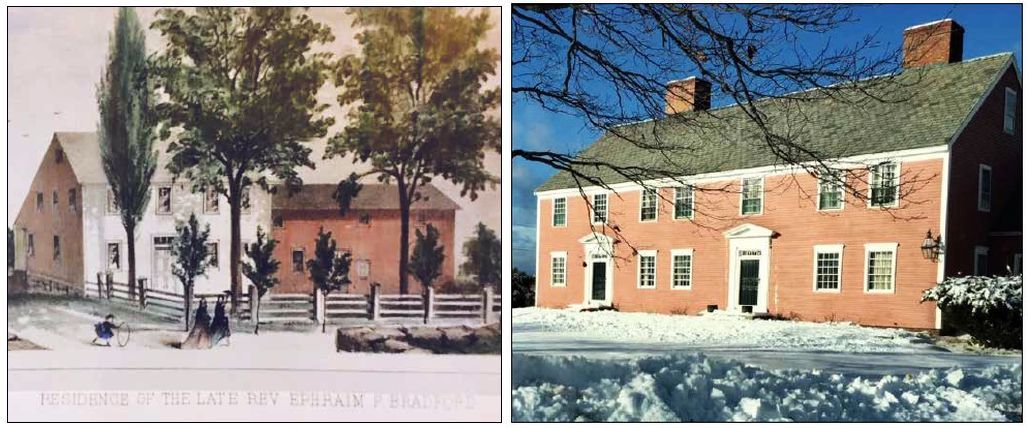New Boston Historical Society
New Boston, New Hampshire

The residence of the late Rev. Ephraim Bradford (painted between 1853 and 1869),
and 1 Bradford Lane as it looks today.
Behind the Door: 1 Bradford Lane — Part One
by Mary Atai (February 2020)
The land was purchased from Thomas Wilson, the first constable in the town. McLaughlin paid 1,140 pounds Old Tenor. Old tenor was paper money issued by the colonial governments. Sometime before 1763, John built the now salmon colored house. He also built a tavern and the first store in town behind the house, which was operated by his son, also named John.
Of historical significance, the second town meeting (1764) and third town meeting (1765) after the town's incorporation, were held in this very house. Following that, the meetinghouse was built where the cemetery is now, and town meetings were thereafter held there.
The McLaughlins were men of great enterprise and were involved in many businesses around the town. After some years, John was found drowned in his own well on this property. Following the investigation in to his death, one of the jurors stated, — "As we could not say, as no one saw him, that he came to his death intentionally, we thought it would be most in harmony with the feelings of the community to say accidental, and that was our verdict."
As it happens, John was a known Tory, and therefore quite unpopular at that time, possibly explaining the lack of interest in getting to the bottom of a probable murder.
The original house was a saltbox style with two windows on one side of the front door and one on the other. There were six rooms, three up and three down, each with its own fireplace. These surrounded a central chimney. The kitchen was in a long narrow room at the back of the house, which now serves as the living room. The kitchen fireplace has Dutch ovens and the room is covered in pine paneling. The parlor, front hall, and a bedroom have paneling attributed to the Dunlap cabinet makers or their apprentice, Samuel Gregg, who worked in this area.
The house was sold to Reverend Ephraim Putnam Bradford in 1805. He was New Boston's second minister, following Reverend Solomon Moor. He was a Harvard graduate, and this served as his only posting for all his life.
He married Mary Manning Barker of Amherst and they had 12 children, 10 who lived, to be raised in this house, all on a salary of 600 dollars per year. With 10 children, they were poor as church mice, but he stayed because he was revered by his flock and he, in turn, loved them. He served for 40 years until his death in 1845, at age 70. S ome highlights of his years of service were that he gave the eulogy for General John Stark in 1822 and he oversaw the building of the new meetinghouse, known as the Church on the Hill in 1823, after the previous meetinghouse on Cemetery Road became inadequate.
Following his death, his widow moved to Milwaukee to be near some of her children in 1846. The ladies of the town presented her with a sympathy quilt with an inscribed gravestone in the center and each square signed, declaring their Christian sympathy. This precious quilt was returned to New Boston from the Manchester Historic Association in 1985 and is held at our Historical Society in the Wason Building.
Editor's note: Part Two continues next month.
Click here to return to the main page for "Behind the Door" articles.
